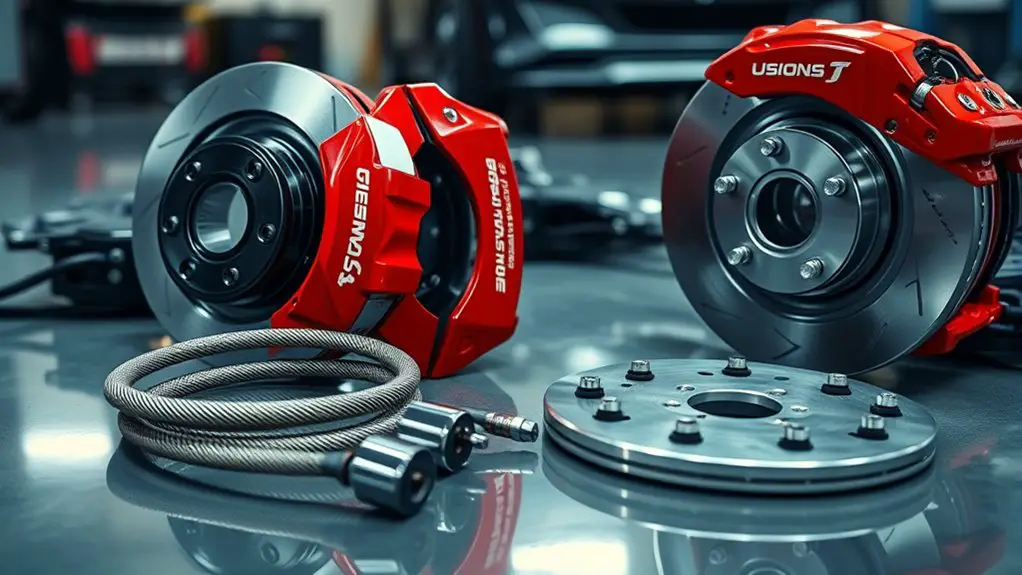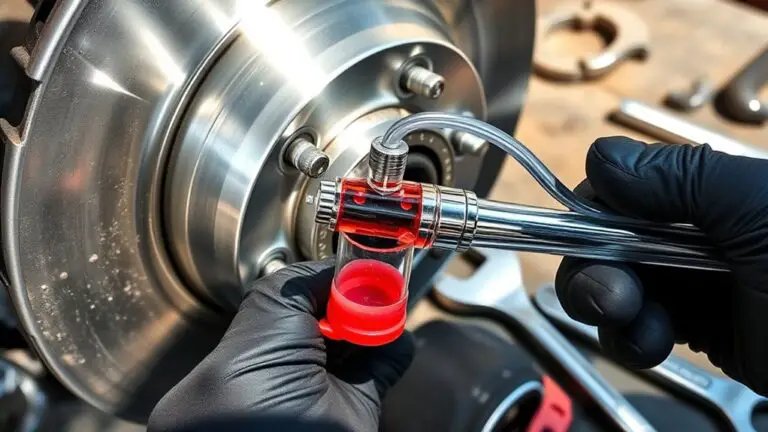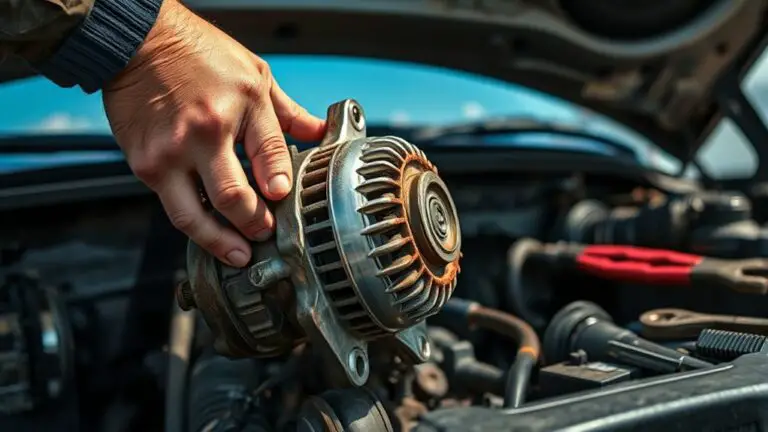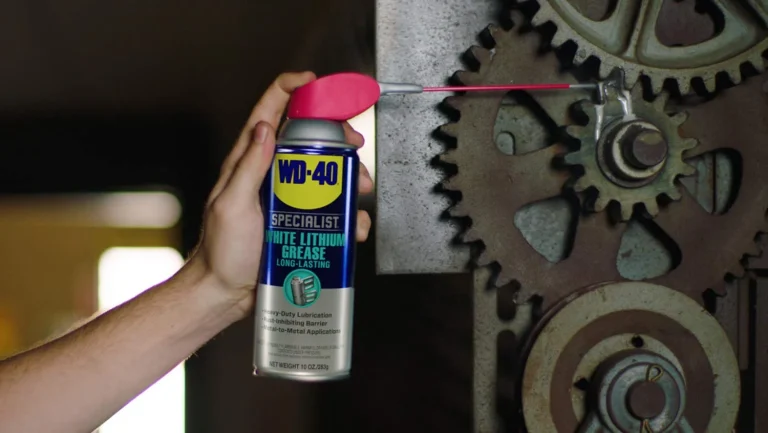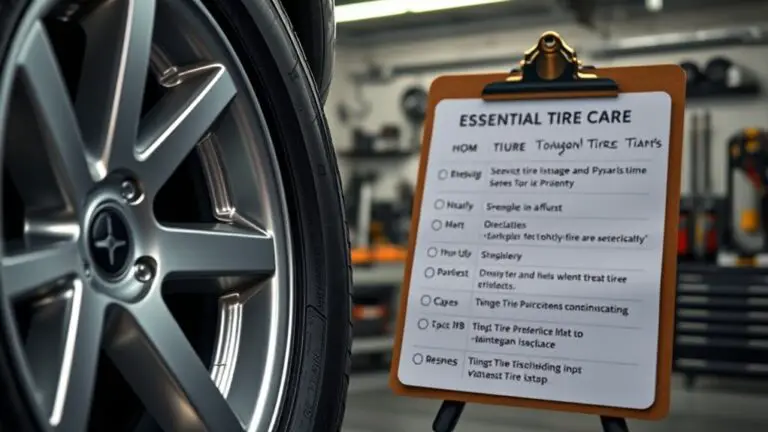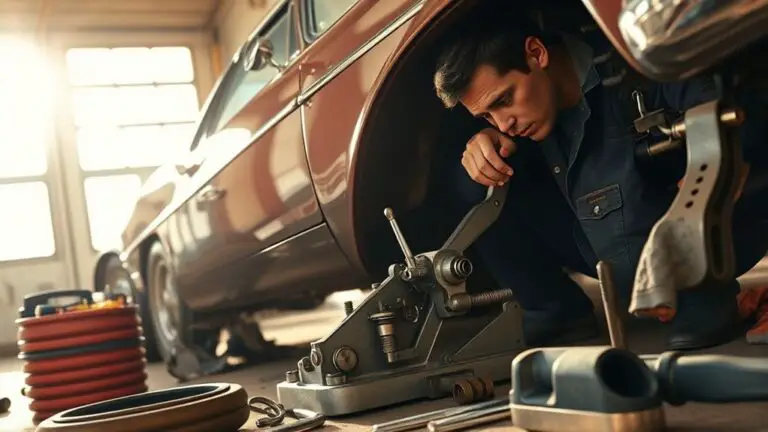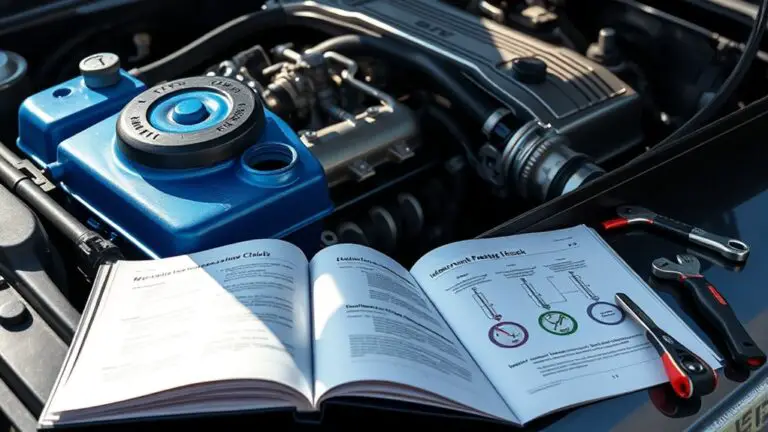How to Source the Right Big Brake Kit to Minimize Excessive NVH After Retrofit on a Tow Rig
To source the right big brake kit for a tow rig and curb NVH, start with exact weight, GVWR, and tongue load, then map braking demand under empty, nominal, and max-tuel load. Check caliper mounting, rotor diameter, hub/spread, and clearances with OEM data. Favor kits tuned for tow duty with stable pad compounds, bedding procedures, and proper ABS/trailer sync. Verify warranty language and install steps; if you keep exploring, you’ll uncover how to optimize fitment and performance.
Assessing Your Tow Rig’s Weight and Braking Demands
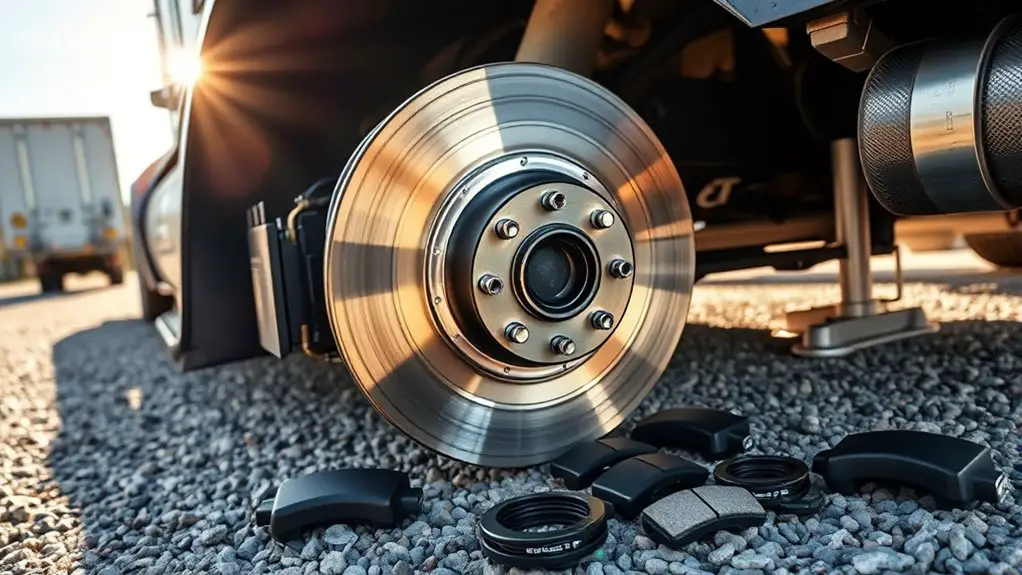
Evaluating your tow rig’s weight and braking demands requires a structured, data-driven approach. You’ll start by gathering accurate tow rig specifications, including axle weight, GVWR, curb weight, and payload capacity. Next, quantify tongue weight and hitch load, then map these to towing duties you actually perform. For braking performance, collect pedal feel, stopping distance, abs engagement, and brake fade history under load. Normalize data by common load scenarios: empty, nominal payload, and max tow weight. Use braking efficiency metrics (deceleration rate, line pressure, rotor temperature rise) to identify performance gaps. Cross-check with manufacturer guidance and applicable friction coefficients for your brake materials. Demand clarity on whether upgrades target gaining stopping power, maintaining control, or reducing NVH. Your goal is to establish a defensible baseline from which big brake kit choices will be evaluated against real-world weight and load profiles, ensuring compatibility with your tow rig specifications and desired braking performance.
Evaluating Existing Hardware and Clearance Considerations
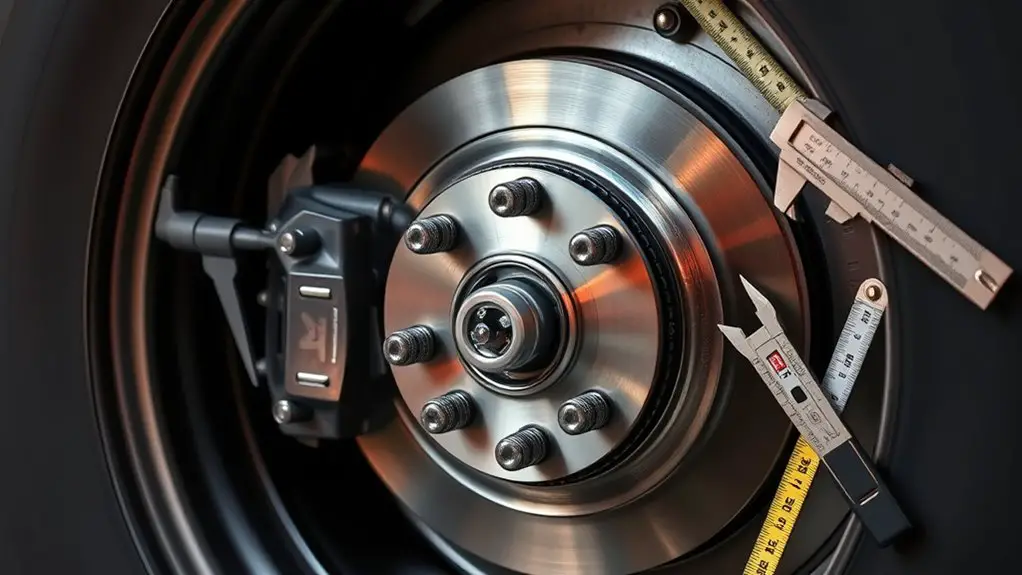
To assess whether a big brake kit fits your tow rig, you first need to map existing hardware and clearance against fitment requirements. You’ll catalog rotor diameters, hub spacing, caliper mounting points, and knuckle geometry, then align these with the kit’s spec sheet. Document measured clearances at wheel bearing housings, control arms, and subframe components under static and full-range suspension travel. Prioritize caliper clearance to wheel spokes, rotor hats, and dust shields, noting any interference risks. Compare hardware compatibility: mounting holes, bolt sizes, stud pitch, and caliper emplacement relative to rotor faces. Use a matrix to flag potential conflicts, color-coding “OK,” “caution,” and “red flag.” Quantify margins—minimum and maximum tolerances—to estimate real-world NVH shifts. Factor auxiliary fitments like ABS sensors, brake lines, and ambient heat paths. The goal is a precise go/no-go decision that preserves braking performance without surprise fit issues.
Caliper Design Basics for Tow Applications
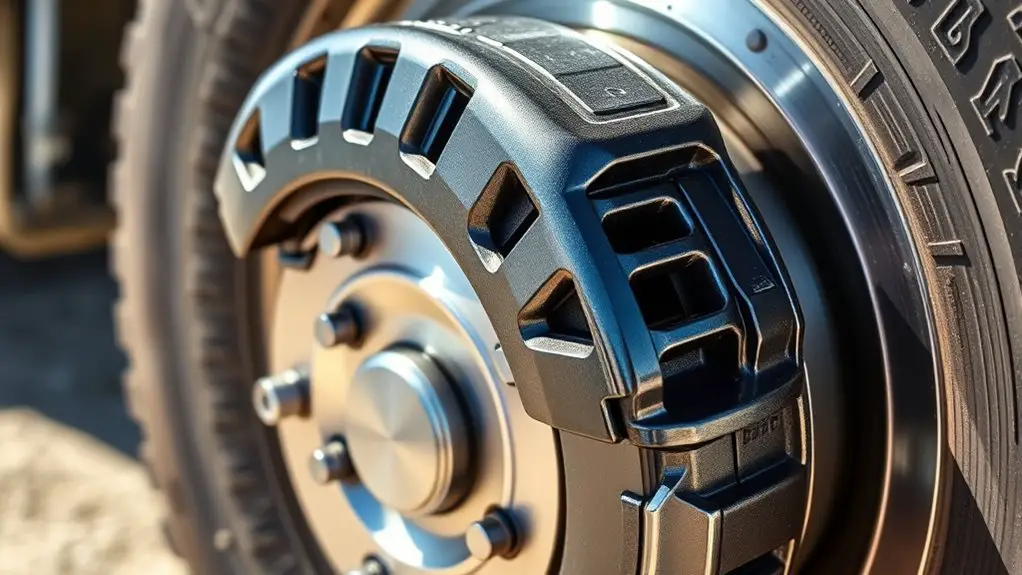
You’ll assess caliper latch mechanics, focusing on reliability under load and ease of engagement during repeated cycles. The discussion should quantify mounting and alignment tolerances, linking them to consistent pad contact and rotor wear across tow scenarios. In doing so, you’ll compare data on misalignment margins, mounting stiffness, and tolerance stacks to determine their impact on braking performance and kit longevity.
Caliper Latch Mechanics
Caliper latch mechanics are critical in tow-rig braking systems because the latch must reliably secure the caliper under dynamic loads while permitting smooth engagement and retraction. You’ll assess latch-stroke tolerance, engagement force, and backlash across temperature ranges to minimize NVH. Data-driven checks show that material hardness and surface finish directly affect stick-slip behavior, so you’ll compare caliper materials for symmetry and wear resistance. You’ll map cycle life versus load to predict latch wear and retainment margins, then quantify engagement smoothness with return-to-rest measurements. Latch mechanisms should maintain consistent preload to prevent caliper binding without overconstraining movement. In practice, you’ll prioritize predictable release under rapid deceleration, using modular latch designs that accommodate minor tolerances while preserving reliability and freedom in operation.
Mounting and Alignment Tolerances
Mounting and alignment tolerances dictate how the caliper sits relative to the rotor and wheel hub, and small misalignments can amplify heat, wear, and NVH under tow. You measure bore-center and rotor-surface runout, then compare to caliper mounting face flatness and bracket parallelism. Use mounting brackets designed with compliant, repeatable fasteners to maintain position under load. Documented clearance targets guarantee piston alignment with the rotor’s hydraulic axis, reducing binding and uneven pad wear. Alignment tools—dial indicators, laser guides, and fixture depths—provide repeatable references for wheel hub flange, rotor shim stack, and caliper position. Consider dynamic cant and hub runout during braking events, not just static fits. A disciplined tolerance stackup improves fade resistance, rotor wear, and overall NVH consistency for tow applications.
Rotor Material and Diameter: Impact on NVH and Cooling
Rotor material and diameter directly influence both NVH (noise, vibration, harshness) and cooling performance. You’ll see material choices alter resonance, thermal conductivity, and pad interface behavior, which translates to measurable NVH shifts under load. Heavier rotors tend to dampen high-frequency chatter but may elevate unsprung mass, increasing axle sway and perceived roughness. Lighter alloys reduce inertia for quicker response, yet can amplify vibrational modes if damping isn’t engineered in. Diameter changes affect cooling because larger rotors expose more surface area and enable longer pad contact paths, improving cooling efficiency but potentially widening brake runout tolerances. Material grade also governs thermal expansion and crack resistance, influencing fatigue life in tow-duty cycles. When selecting rotor types, balance thermal capacity, weight, and stiffness to minimize heat soak in the axle housing. Aim for data-backed specs on thermal conductivity and diameter tolerance to achieve predictable NVH results without compromising cooling efficiency or reliability.
Pad Compounds and Bedding Procedures for Heavy Loads
Pad compoundsfor heavy loads must balance friction behavior, temperature tolerance, and wear resistance to maintain consistent braking under tow conditions. You’ll evaluate compounds by friction stability across speed and heat ranges, targeting a narrow friction coefficient window to reduce NVH and pedal fade. Data-driven selection considers fade resistance, rotor interaction, pad bite, and pad-to-plate wear rates under sustained tow loads. Use pad selection strategies that compare testing curves from similar heavy-vehicle profiles, climates, and brake duty cycles, not just label specs. Bedding techniques become critical: a controlled ramp, gradual heat buildup, and verified cooling cycles to form a uniform transfer layer without glazing. Document measured values: peak and steady-state temperatures, fade onset, and wear depth per 10,000 miles. Preference should favor compounds with proven low hot plateau variance and predictable torque at the wheel. Align pad choices with real-world load cases, warranty data, and maintenance plans for durable performance.
Ensuring ABS and Trailer Brakes Compatibility
You’ll want to assess ABS-Tow Compatibility, ensuring the system integrates with trailer brakes through precise load and sensor data. Start by comparing calibration ranges, synchronization windows, and response times to confirm consistent braking signals across both axle sets. Use a data-driven checklist to verify ABS calibration tips and trailer brake synchronization, then document any deviations for corrective action.
ABS-Tow Compatibility
When selecting a big brake kit for a tow rig, you should start by mapping how the vehicle’s ABS logic interacts with trailer braking systems, since incompatibilities can lead to false ABS activations or reduced stabilization during braking.
ABS-Tow compatibility hinges on how brake modulation and hydraulic balance are managed across the system. Look for kits with integrated or compatible electronic interfaces that respect trailer brake signals and wheel speed data. Favor configurability that preserves anti-lock cycles without lag or overreaction, and verify presence of diagnostic clarity for ABS alerts.
| Brake signal source | Modulation approach | Diagnostic clarity |
|---|---|---|
| Vehicle ABS | Hydraulic balance control | Clear fault codes |
Trailer Brake Sync
Trailer Brake Sync is about aligning vehicle ABS signals with trailer braking to prevent false activations and uneven deceleration. You’ll evaluate how trailer weight impacts brake controller performance and ABS timing, then calibrate thresholds to maintain stable deceleration across loads. A data-driven approach minimizes NVH by aligning sensor cues with actual wheel torque, reducing slip-induced yaw and brake fade. You’ll quantify variation across towing scenarios, identify outliers, and set guardrails that preserve steering feel while maximizing stopping power. Precision tuning is essential when switching payloads or tow rigs, ensuring harmonized braking at all speeds. The result is predictable, freedom-driven braking behavior that respects both your ride and the trailer’s dynamics.
- Assess trailer weight impact on ABS/trailer brake interaction
- Calibrate brake controller thresholds for varied payloads
- Monitor deceleration consistency across speeds
- Establish repeatable, data-backed adjustment procedures
ABS Calibration Tips
With the groundwork from Trailer Brake Sync in mind, ABS Calibration Tips focuses on aligning anti-lock braking system signals with trailer braking performance to prevent false activations and uneven deceleration. You’ll approach calibration as a data-driven process: collect baseline brake response, compare ABS event timing to trailer sensor data, and identify lag or early activation patterns. Prioritize ABS tuning to match deceleration profiles across loaded and unloaded states, ensuring consistent wheel-speed readings from all sensors. Perform sensor calibration to verify accuracy of each wheel’s speed data and correct any drift that skews modulating pressure. Document targets, tolerances, and real-world results for repeatable setups. Finalize with conservative thresholds that preserve stability while avoiding brake lock, then revalidate under varied braking scenarios.
Fitment Verification: Wheel, Offset, and Hub Compatibility
Ensuring proper fitment starts with a precise comparison of wheel specs to your tow rig’s hub, offset, and bolt pattern. You’ll verify wheel size and offset measurements against the rotor/caliper envelope, ensuring clearance at full lock, suspension travel, and steering angles. Assess hub design compatibility, including hub bore and spline fit, to avoid spin and runout. Confirm tire compatibility with load index, section width, and overall diameter to maintain accurate ABS and speedometer readings. Document tolerances, then validate with measured gaps and actual mounting tests before final torque.
Ensuring proper fitment requires precise wheel-spec checks against hub, offset, and bolt pattern for safe clearance and mounting.
- Confirm wheel size, offset measurements, and bolt pattern match at the rotor/caliper interface
- Verify hub bore, center bore tolerance, and spline fit for concentric alignment
- Check tire compatibility against load index, width, and overall diameter
- Validate clearance under full steering lock and suspension travel during dynamic tests
OEM-Quality Upgrades vs. Gimmicks: Reading the Fine Print
How do you separate OEM-quality upgrades from gimmicks when evaluating brake components for tow rigs? You examine the fine print and demand data, not marketing hype. Start with OEM standards: confirm that the design, materials, and testing align with factory specs, including heat tolerance, friction coefficients, and durability under heavy towing. Compare aftermarket choices against those benchmarks, not just price. Look for independent performance longevity data: third-party tests, long-term wear rates, and real-world NVH trends under load. Scrutinize the claims in product reviews: isolate bias, verify sample sizes, and weigh anomalies against repeatable results. Beware gimmicks masquerading as upgrades—unverifiable claims, undocumented coatings, or questionable sourcing. A robust decision balances cost, warranty scope, and proven performance over time. Your goal is a documented, repeatable evaluation framework that preserves capability without compromising safety or reliability.
Practical Installation Steps to Minimize NVH and Preserve Warranty
When installing brake components for towing, you’ll want a methodical approach that minimizes NVH and protects warranty coverage. You’ll baseline with OEM-referenced torque specs, measure rotor runout, and verify caliper alignment to avoid binding. Document installation techniques and any deviations, so future service can prove due diligence. Use data-driven decisions: track rotor surface finish, pad material compatibility, and fluid temperature behavior under load. Prioritize components with documented warranty considerations from the kit maker and vehicle manufacturer, and retain receipts and install notes. Avoid shortcuts that compromise NVH performance or void warranty. Conduct road testing in progressive steps, logging brake feel, pedal travel, and noise at known speeds and loads. If NVH shifts beyond thresholds, revert to certified procedures or consult the supplier. Maintain a clean, labeled installation environment to support warranty audits and future maintenance. Your goal: repeatable, auditable results that respect limits and freedoms.
- Follow torque and alignment specs precisely
- Log all measurements and deviations
- Compare data against baseline tests
- Retain all warranty documentation
Frequently Asked Questions
How Does Rotor Weight Affect Tow Rig NVH Levels?
Rotor weight directly shapes tow rig NVH: higher rotor inertia tends to elevate drivetrain resonance and braking-induced vibrations, while balanced weight distribution minimizes peak NVH. You’ll see smoother deceleration with optimized rotor inertia and even weight distribution across axles, reducing oscillatory Modes. Data suggests marginal weight adds decoupled rotor mass can worsen NVH unless offset by dampening and alignment. You should model rotor inertia against wheel load, then tune balance for sustained, freedom-driven performance.
Can Oversized Calipers Impair Trailer Brake Synchronization With ABS?
Yes, oversized calipers can impair trailer brake synchronization with ABS, because caliper size alters piston travel and pad contact timing, disrupting ABS modulation. You’ll see mismatched bite when caliper size exceeds rotor and sensor tolerances, degrading ABS functionality and braking harmony. Analyze data: compare caliper mass, piston area, and rotor diameter against OEM specs; verify ABS wheel-end signals, then test with controlled deceleration. If discrepancies arise, revert to appropriately sized calipers to preserve ABS reliability and performance.
Do Brake Pad Compounds Impact Trailer Wheel Bearing Life?
Brake pad compounds do impact trailer wheel bearing life, yes. You’ll impact heat and vibration, which accelerates wear if the pad’s performance isn’t consistent. You’ll want to monitor brake pad performance across load scenarios and maintain ideal trailer load distribution to minimize heat pockets. Anticipate the objection “pads last forever,” but data shows wear rate rises with higher temps. Track temps, pad wear, and braking efficiency to protect bearings and sustain performance with freedom-driven analysis.
Will Aftermarket Rotors Require Wheel Hub Modification or Spacers?
Yes, aftermarket rotors can require hub modifications or spacers depending on your setup. You must verify rotor compatibility with your hub dimensions and bolt pattern, then assess spacer installation tolerances and load paths. In practice, measure offset, thickness, and lug alignment, and compare to your rotor spec sheet. If mismatches appear, plan precise machining or adapter spacers. Document torque, clearances, and test under load to maintain safety and performance.
What Warranty Implications Come From Non-Oem Brake Upgrades?
Warranty implications from non-oem brake upgrades can vary, but you’ll typically face reduced warranty coverage and potential voids if aftermarket parts cause damage. You should document compatibility, keep receipts, and note installation specifics. Legal considerations matter, so verify manufacturer terms and applicable lemon laws. Stay data-driven: compare claims history, failure rates, and shop notes. If you pursue upgrades, weigh performance gains against warranty coverage limits, ensuring you preserve some recourse should issues arise.

